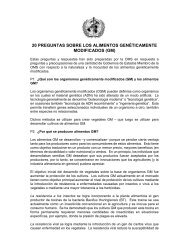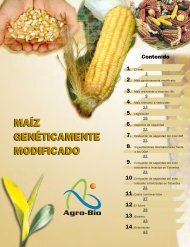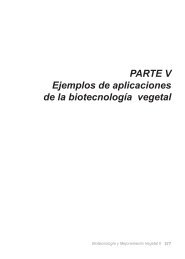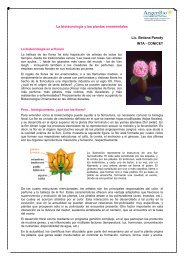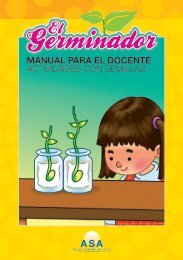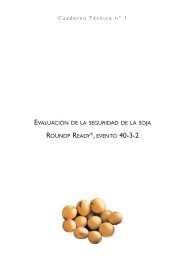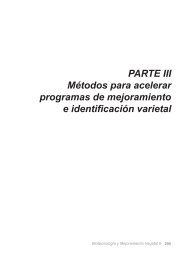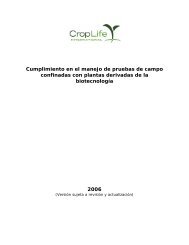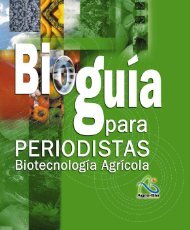New Genetics, Food and Agriculture: Scientific ... - ArgenBio
New Genetics, Food and Agriculture: Scientific ... - ArgenBio
New Genetics, Food and Agriculture: Scientific ... - ArgenBio
You also want an ePaper? Increase the reach of your titles
YUMPU automatically turns print PDFs into web optimized ePapers that Google loves.
28N E W G E N E T I C S, F O O D A N D A G R I C U LT U R EFish: The possible release of genetically modified fish intoa q u atic env i ronments po s es an o ther distinct set of issues,which also need to be assessed on a case-by-case basis (Pew2003). A key issue is the potential ability of transgenic fish tocross with, <strong>and</strong> out-compete wild populations.Issue 2. Indirect effects on biodiversity<strong>and</strong> the environmentCHANGING AGRICULTURAL AND ENVIRONMENTALPRACTICESI n d i rect env i ro n m e n tal effects may result from chan g i n gagricultural <strong>and</strong>/or environmental practices that result fromspecific applications of modern genetics, including the use ofliving modified organisms with particular traits. For example:Pesticide use: The use of GM crops with insect resistance(Bt crops) is reducing the volume <strong>and</strong> frequency of pesticideuse on co tton, corn <strong>and</strong> soy be an ( Car pe n ter et al. 2002).Bt co tton crops are also having demonstra ble be n e fi c i a leffects on human health <strong>and</strong> the environment in China, Australia<strong>and</strong> So uth Afr i ca ( Pray et al. 2000; ISSAA 2002a ) byreducing exposure to chemical pesticides.Herbicide use: The exp<strong>and</strong>ing use of pesticides (includingherbicides) has been a major cause of the decline in farml<strong>and</strong>b i rd s, ara ble wild pl ants <strong>and</strong> insects in the UK as sui ta bl eh a b i tats disappe ared. The more wides p read use of broa d -spectrum herbicides in the UK as a result of the cultivation ofherbicide tolerant crops (such as oilseed rape <strong>and</strong> sugar beet)may accelerate this trend (Johnson in CGIAR 2000a).L<strong>and</strong> us e : The future development of new crops withimproved tolerance to abiotic factors (such as drought, salinity<strong>and</strong> frost) <strong>and</strong> the advent of crops that may be used to produce va cc i n es an d /or indus trial products may also chan g ecrop management <strong>and</strong> l<strong>and</strong> use practices. These trends maybe either env i ro n m e n tally be n e ficial or dam a g i n g, depe n d-ing on the particular crop/trait/environmental situation.Crops with tolerance to abiotic stresses may increase pressure on natural biod ive rs i ty when crop cu l tivation exte n d sinto marginal l<strong>and</strong>s, or into areas not presently used for agriculture.For example, salt tolerant rice may be able to be cultivatedin coas tal are as wh e re man groves pres e n tly grow,with resulting ecological changes in l<strong>and</strong> <strong>and</strong> water use <strong>and</strong>associated plant <strong>and</strong> marine life. Gene technology may alsobe used in env i ro n m e n tal re m e d i ation, for exam ple in th eremoval of toxic compounds from soil.ENVIRONMENTAL BENEFITS OF GENETICALLYMODIFIED CROPSB i o te c h n ol ogy - d e r ived crops provide options <strong>and</strong> po te n-tial solutions for a number of challenges in modern agriculture.The extent to which th ey may be the pre fe r red opti o nd e pends on many economic, social, <strong>and</strong> regional fa c to rs .Several general conclusions about the environmental benefitsof biotechnology-derived soy bean, corn, <strong>and</strong> cotton havebeen documented by studies in the USA <strong>and</strong> elsewhere (CAST2002). These studies concluded:• Biotechnology-derived soy bean, corn, <strong>and</strong> cotton providei n s e c t, we e d, <strong>and</strong> disease management options th at areconsistent with improved environmental stewardship.• B i o te c h n ol ogy - d e r ived crops can provide sol utions toe nv i ro n m e n tal <strong>and</strong> economic problems as s oc i ated withconventional crops including production security (consistentyields), sa fety (worker, public, <strong>and</strong> wildlife), <strong>and</strong> environmentalbenefits (soil, water, <strong>and</strong> ecosystems).• Al though not the only sol ution for all farming situ ati o n s,the fi rst co m m e rcially avai l a ble biote c h n ol ogy - d e r ive dcrops provide benefits through enhanced conservation ofsoil <strong>and</strong> wate r, incre ased be n e ficial insect po p u l ati o n s<strong>and</strong> improved water <strong>and</strong> air quality.Issue 3. Adequacy of methods for assessingenvironmental effectsAREAS OF CONVERGENCEThere is broad agreement that there needs to be sciencebasedenvironmental impact assessments of the risks posedby the release of genetically modified crops <strong>and</strong> other livingmodified organisms into the environment.The types of risks posed by the re l e ase of Living Mod i fi e dO rg anisms (LMOs) into the env i ronment are similar in kind to



